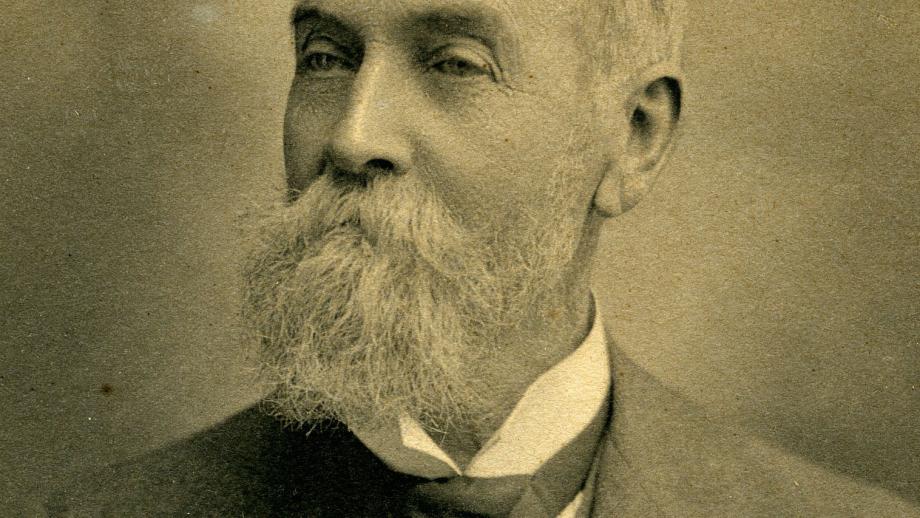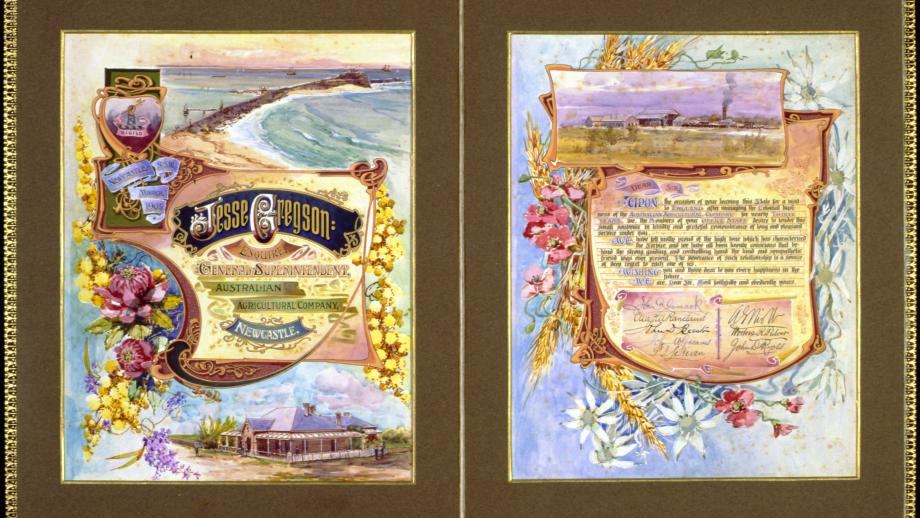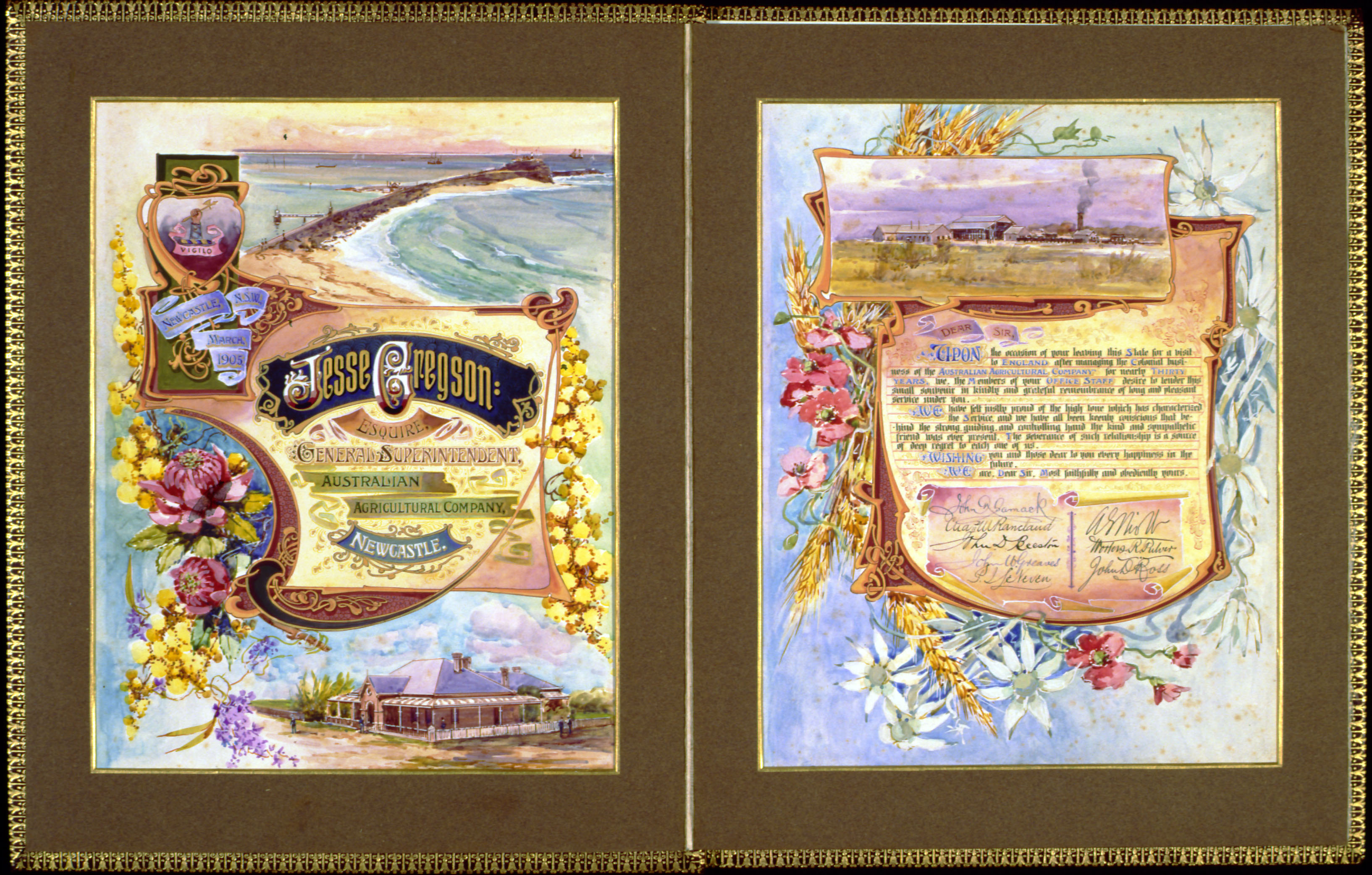Leaders of the 20th Century
Jesse Gregson (General Superintendent 1875-1905)
In 1856 at the age of 18, Jesse Gregson left England for Australia, armed with £50 and letters of introduction to a variety of people who may assist him in the colony, including brewers Robert and Frederick Tooth. Gregson was unable to secure employment in Sydney and subsequently took up an offer from Alexander Busby, who he had met on the voyage from England. This led to Gregson securing work at the pastoral station ‘Collaroy’ in the Upper Hunter region of New South Wales. This station was originally owned by Walter Stevenson Davidson, the Australian Agricultural Company’s largest shareholder, then managed by E.W.T. Hamilton who became the Company’s Governor, so Gregson would have been known to some of the Company’s directors. Within two years Gregson had worked his way up the position of Head Overseer.
Gregson’s association with Busby continued, when in May 1860, they overlanded 5,000 ewes to a new station, ‘Rainsworth’, near the future town of Springsure in Queensland (Gollan 2006). The early years at ‘Rainsworth’ were very challenging but Gregson became the first in the district to use wire fencing and successfully fenced 20,000 acres of the property.
In 1870 Gregson’s partner Busby was elected to the Australian Agricultural Company Court of Directors. Following the resignation of Edward Merewether as General Superintendent, Busby recommended Gregson for the position. He was appointed in 1875 and held the position until 1905, by far the longest serving General Superintendent to date. He applied himself with vigour to the care of the company's extensive pastoral and mining properties and his detailed reports to London reveal his energy and precise knowledge (Gollan 2006).
Gregson oversaw improvements at Warrah including the completion of rabbit-proof fencing and during his tenure the Company completed the disposal of its Port Stephens Estate.
Gregson took a very active role in the Company’s coal mining operations and acted as a spokesperson for colliery proprietors in their dealings with miners and trade unions. He believed that it was wrong for miners employed by different companies to make common cause in a single union, and notably in 1882 he attempted several times to split the union by cutting the hewing rate and precipitating a strike, although he insisted that he was not opposed to trade unionism as a principle, just the Australian Agricultural Company’s miners joining with other miners with whom they had little in common (Gollan 2006).
During the 1890 Maritime Strike Gregson joined the intercolonial conference of employers which directed the strike on the employers' side and in 1890-1891 he served on the royal commission on strikes (Gollan 2006). Gregson was appointed to the royal commission which prepared the case for the Coal Mines Regulation Act 1896, which created much more rigorous regulations for health and safety of miners than previous Acts (Gollan 2006).
Gregson’s great passion outside his work was botany and he sent large collections of specimens to the Botanic Gardens of Sydney from the Blue Mountains where he had built a summer home at Mount Wilson. While living here he wrote his history of the Company The Australian Agricultural Company 1824-1875, and he reputedly bored Company directors by reading them his latest chapter whenever they visited.
Gregson was well-respected by the employees of the Company. Upon his retirement he was presented with an illuminated address housed in a hand-crafted wooden box. The address included the text written by the Newcastle Office staff “we have felt justly proud of the high tone which has characterised the service, and we have all been keenly conscious that behind the strong guiding and controlling hand the kind and sympathetic friend was ever present”.
Gregson retired from the Company in 1905 and died on 3 August 1919 at the age of 82.
References
Gollan, R 2006, Jesse Gregson (1837-1919), Australian Dictionary of Biography, National Centre of Biography, Australian National University, < https://adb.anu.edu.au/biography/gregson-jesse-3665>
Frederick Livingstone-Learmonth (General Superintendent 1905-13)
Frederick Livingstone-Learmonth was born at Ercildoun near Ballarat in Victoria in 1862. Returning to Australia in 1883 after completing his schooling in England, he began working on his father’s pastoral property ‘Bringagee’ on the Murrumbidgee in New South Wales.
In the late 1800s, Livingstone-Learmonth travelled to Greece to work as a correspondent for The Times and when war broke out in South Africa, he immediately volunteered to serve with the New South Wales Contingent. He was promoted to lieutenant and highly decorated for his efforts in the field.
In 1903 Livingstone-Learmonth was nominated by Jesse Gregson to succeed him as General Superintendent of the Australian Agricultural Company, with his pastoral and military experience serving him well in the position. Livingstone-Learmonth had held the position of Gregson’s assistant and spent his first year acting in the General Superintendent position before being offered permanency in 1905.
Hebburn Colliery, managed by the Australian Agricultural Company, began to yield a profit just as Livingstone-Learmonth took over as General Superintendent, and the mine pioneered coal-cutting machinery, but there was also conflict under Livingstone-Learmonth’s tenure. He spearheaded the confrontation that led to the disastrous strikes of 1909 and as secretary to the Associated Northern Collieries and secretary (later chairman) of the Hunter River District Colliery Proprietors' Defence Association, his conservatism and militancy contributed to deadlocked negotiations with the union leader Peter Bowling (Atchison 2006).
Livingstone-Learmonth found himself in conflict with the government on a number of occasions, most notably in relation to the government’s resumption of over 45,000 acres of the Company’s land at Warrah in 1911 and the federal land tax introduced in 1910, which he described as crushing (Atchison 2006).
After the loss of land at Warrah through the government’s forced resumption, Livingstone-Learmonth recommended the Company offset this to some extent by purchasing Corona Station near Longreach, Queensland, which was owned at the time by his family’s Groongal Pastoral Company.
Following his wife’s sudden death in 1912 and the feeling that his workload had left him “utterly worn out and almost broken down”, Livingstone-Learmonth resigned on 31 March 1913 and returned to England (Atchison 2006). He maintained directorships in the Australian Agricultural Company and Bank of Australasia and acted as a confidante to new Governor Charles Gibbs Hamilton until his death in 1945.
References
Atchison, J 2006, Frederick Valiant Livingstone-Learmonth (1862-1945), Australian Dictionary of Biography, National Centre of Biography, Australian National University, < https://adb.anu.edu.au/biography/livingstonelearmonth-frederick-valiant-7214>
John Stanley Christian (General Superintendent 1913-20)
(John) Stanley Christian’s parents William and Emma arrived in New South Wales from Cornwall in 1842 and took up the properties ‘Mount Pleasant’ at Hinton and later ‘Walhallow’ and ‘Tenterfield’ on the Liverpool Plains in New South Wales, followed by properties in Queensland and the Northern Territory.
As a young man, Christian managed properties for his father before being appointed Manager of the Gloucester Stud Farm for the Gloucester Syndicate in 1903. The Syndicate had purchased the Gloucester Estate and its cattle from the Australian Agricultural Company.
In 1909 Christian was appointed Assistant to the Australian Agricultural Company’s General Superintendent Frederick Livingstone-Learmonth, and in that capacity attended the Gloucester Stud dispersal sale to purchase cattle for the Company’s Warrah herd.
In April 1913 he succeeded Livingstone-Learmonth as General Superintendent, serving in this role until 1920.
Christian’s tenure was eventful and during his time as General Superintendent he oversaw the purchase of Corona and Bladensburg Stations in Queensland, further development of the Hebburn Colliery and Newcastle Estate, land sales at East Warrah, the closure of the Sea Pit in Newcastle (the last of the Company’s coal mines), and the 1916 General Coal Strike.
James Henry (General Superintendent 1919-32)
James Henry’s family arrived in Melbourne from Kent in 1876, when he was 13 years old. After completing his education at Scotch College, Henry gained experience working on pastoral stations including ‘Walla Walla’ near Albury, ‘Widgewa’ between Urana and Narrandera, Annandale Estate near Blayney, and ‘Beneramhah’ on the Murrumbidgee, before being appointed Manager of the Australian Agricultural Company’s Warrah Estate in 1912.
In 1919, Henry was appointed General Superintendent of the Company, succeeding Stanley Christian. Henry’s tenure was punctuated by drought, which was particularly severe between 1925 and 1928, the Great Depression in 1929, and a grasshopper plague in 1930.
Henry’s tenure included significant changes at Newcastle. Thirty-seven acres of the Hamilton Swamp and twenty-one acres in South Newcastle were reclaimed and filled, with much of the area then developed as the Hamilton Garden Suburb in Newcastle. He negotiated extensively with Newcastle and Hamilton Councils over streets and auctions in the area. However, the Great Depression resulted in a drop in sales and coal strikes further frustrated the Company’s efforts in Newcastle.
During the early 1920s, Henry imported four pedigree shorthorn cattle from England and Uardry rams for Corona Station in Queensland.
In October 1932, Henry took an extended period of leave and was succeeded by J.F. (John Francis) Holloway, who was already General Superintendent of the Peel River Land and Mineral Company.
Henry retired to Sydney and died at his home in Pymble in 1946 at the age of 83.
John Francis Holloway (General Superintendent 1930-41)
John Francis Holloway was the first General Superintendent to manage both the Australian Agricultural Company and the Peel River Land and Mineral Company.
Holloway was born into a pastoral family at Mumbledool Station near Narrandera in New South Wales and after completing his schooling, worked at Murrill Creek Station near Grong Grong, New South Wales, before becoming manager at various stations in New South Wales and Queensland including Bindybango and Windouran. His work paused while he served with the Australian Army during the First World War.
In 1919, Holloway was appointed manager of the Australian Agricultural Company’s Warrah Estate on the Liverpool Plains in New South Wales. He was manager there until 1930 when he moved to Goonoo Goonoo on the Peel Estate, owned by the Peel River Land and Mineral Company. He was appointed General Superintendent of both the Australian Agricultural Company and the Peel River Land and Mineral Company and oversaw the interests of both companies from Goonoo Goonoo, with responsibility for the Companies’ thousands of sheep and cattle across New South Wales, Queensland, and the Northern Territory.
In addition to his work for the Companies, Holloway was a government representative on the Meat Board, member of the Cattle Council, member and vice-president of the Graziers’ Association, and member of the Unions Club and Royal Automobile Club (Narrandera Argus and Riverina Advertiser 10 Jan 1941).
Holloway died at Goonoo Goonoo in 1941 at the age of 70.
Rudolf (Dolf) Schmidt (General Superintendent 1941-62)
Rudolf (Dolf) Schmidt was born in Cunnamulla, Queensland, in 1895. His grandfather Hans Schmidt emigrated to South Australia from Germany in 1854. Schmidt’s father John bought the Merino stud Goolburra near Cunnamilla, Queensland, followed by Bando Station at Wynadra (1908) and Alroy Downs on the Barkly Tablelands (1914).
Schmidt enlisted as a private in the 11th Light Horse in 1915 and served in Egypt and Palestine. He was commissioned as 2nd Lieutenant in 1919 before being discharged and returning to Australia to take up the position as manager of Alroy Downs Station for his father.
In 1935, Schmidt was appointed manager of the Australian Agricultural Company’s Warrah Estate and Assistant General Superintendent of the Company before leaving for personal reasons in 1937. However, in 1940 he returned to the Company, being appointed General Superintendent following the death of J. F. Holloway.
When Schmidt took over management of the Company, its stations included Warrah in New South Wales, and Corona, Bladensburg, Headingly, and Caldervale in Queensland, but during his time the Company made several more acquisitions including the properties of James McLeish Pty Ltd at Coonamble (1946); Brewon (1947); Rockhampton Downs and South Galway (1949); Auvergne, Newry, and Argyle (1950) – the result of purchasing the company Connor, Doherty & Durack; Brighton Downs (1951); Budgerygar (1953); and Toolebuc and Drildool (1957). There were also significant land sales and resumptions including the resumption of ten acres of former Sea Pit land at Newcastle; a large portion of Corona Station in Queensland resumed by the Queensland Government in 1954; and more of Warrah resumed by the New South Wales Government in 1955.
Schmidt oversaw the Company’s establishment of a Santa Gertrudis cattle stud in 1955, with the importation of Santa Gertrudis cattle from Texas. The first-class herds of Shorthorn and Poll Shorthorn cattle on the Company’s properties today are evidence of his ability. In addition to these herds, Mr Schmidt established a stud of Santa Gertrudis cattle with females imported direct from Texas. Schmidt’s entries at the Sydney Royal Show won top honours and realised high prices (Pastoral Review, 16 August 1962).
Schmidt resided at Kimberley Grange, with his son Trevor living at the Goonoo Goonoo homestead. The house was on 671 acres on the highway, due west of the homestead and was purchased from the Peel River Land and Mineral Company by R.T. Schmidt Pty Ltd in 1958.
Schmidt was visiting properties in the Northern Territory when he died suddenly of a heart attack at Argyle Downs Station on 29 September 1962 at the age of 67. A marble plaque was placed in the Goonoo Goonoo Chapel after his death “by those privileged to serve under him at Goonoo Goonoo” (Monument Australia nd).
Roy Trevor Schmidt (Managing Director, 1963-88)
Roy Trevor Schmidt (known as Trevor) was the son of Rudolf Schmidt, his predecessor at the Australian Agricultural Company.
Schmidt was born into a pastoral family and raised on his grandfather’s property in the Northern Territory until leaving to complete his schooling in Sydney.
Schmidt managed pastoral stations throughout the 1950s and 1960s before being appointed Managing Director of the Australian Agricultural Company and the King Ranch Pastoral Company in 1963, following the sudden death of his father. He held this role until 1988.
Schmidt was very active in the Royal Agricultural Society of New South Wales. He was elected to its Council in 1963, before being elected Vice President in 1980. In 1988, as Schmidt stepped down from his position as Managing Director of the Australian Agricultural Company, he took on the role of President of the Royal Agricultural Society of New South Wales, a position he held until 1995. As President, he played an integral role in expanding the Society and lifting the profile of the Society’s Royal Easter Show (Royal Agricultural Society of New South Wales 2024).
In 1999 Schmidt received an Order of Australia to honour his service to the public.
He died in 2014.
References
Royal Agricultural Society of New South Wales 2024, President Roy Trevor Schmidt, < https://www.rasnsw.com.au/archives/heritage-highlights/presidents/president-roy-trevor-schmidt/>
John Lionel Poultney Griffith (Chief Executive Officer 1987-91; Managing Director 1991-99)
John Griffith was born at the property ‘Toonallook’ in the Riverina region of New South Wales in 1944. ‘Toonallook’ had been established by the Griffith Family as a sheep stud, becoming the largest Romney Marsh stud in the world and exporting rams to Argentina.
Griffith completed agricultural science studies at the University of New England and University of Missouri.
In 1987, he became Chief Executive Officer of the Australian Agricultural Company under Managing Director Trevor Schmidt. In 1991, Griffith took on the role of Managing Director, a role he held until 1999.
During Griffith’s tenure the Australian Agricultural Company was enlarged and transformed into an integrated business with specialised areas for breeding, growing and fattening cattle. The Company also developed composite breeds of cattle and during this time constructed the large Goonoo Feedlot in Central Queensland.





